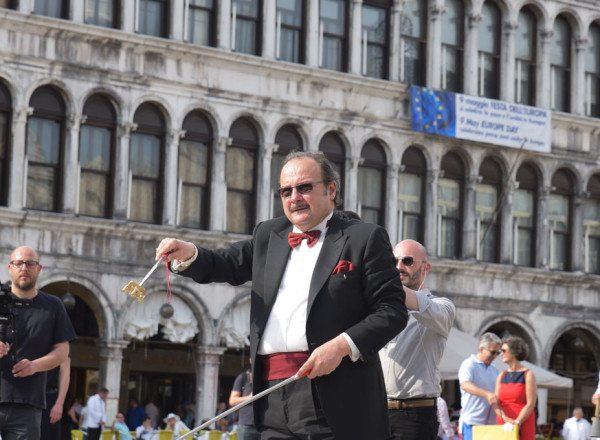Concertino Unisono
Concertino Unisono is a site-specific project by German conceptual artist, theater director and independent curator Michael Staab.
Concertino Unisono is a site-specific project by German conceptual artist, theater director and independent curator Michael Staab.

Concertino Unisono is a site-specific project by German conceptual artist, theater director and independent curator Michael Staab. Since 1992, following several years of work in institutional and independent theaters, Staab has focused on performatively displayed room installations and conceptual art actions and projects. In his temporary site-and context-specific projects, Staab examines the ways in which social systems function, analyzing established views and behavioral patterns of people in familiar situations. His work is interdisciplinary and participatory. The goal of Staab’s work is to create temporary “social sculptures” by promoting the acceptance of an expanded notion of art.
A visit to the Piazza San Marco—”the finest salon in Europe,” as French writer Alfred de Musset described it—is one of the highlights of any trip to Venice. Three renowned cafés are situated in the square: Caffe Florian (established in 1720), Gran Caffe Quadri (1775) opposite, and Caffe Lavena (1750) next door. Traditionally, each of these keeps a small orchestra to entertain clients on the terrace with music of all genres and periods. As a rule, the orchestras alternate their playing so as to avoid acoustic overlapping.
A man dressed in tails appears in the middle of the square and starts conducting. Surprisingly, the orchestras follow his beat, and they all begin playing at once. The resultant musical chaos soon organises itself into an ensemble, and the square is filled with the strains of Johann Strauss’s Blue Danube waltz.
The music of the three orchestras mingles with the babble of tourist voices, the cooing of the pigeons and the noises of the lagoon to form a Concertino Unisono, which is best experienced in the midst of the throng, in constant motion like the Danube itself, or swaying to the rhythm of the waltz. The unison of the orchestras will last only a few minutes before the buzz of the crowd reestablishes the rhythm.
A temporary artwork which appears and disappears, remaining not in a museum but only in the memory of those present. Even if the description of the project suggests a musical theme, this is merely secondary. Concertino Unisono regards itself as classical conceptual action art, an interdisciplinary performative intervention in public space. An existing situation is changed through the non-verbal actions of a single protagonist, altering public perception of reality.
Concertino Unisono is a site-specific project by German conceptual artist, theater director and independent curator Michael Staab. Since 1992, following several years of work in institutional and independent theaters, Staab has focused on performatively displayed room installations and conceptual art actions and projects. In his temporary site-and context-specific projects, Staab examines the ways in which social systems function, analyzing established views and behavioral patterns of people in familiar situations. His work is interdisciplinary and participatory. The goal of Staab’s work is to create temporary “social sculptures” by promoting the acceptance of an expanded notion of art.
The title of this project is a discreet homage to Stravinsky: 3 Easy Pieces is a piano duet that teaches children to play with four hands and was composed in 1915 just after The Rite of Spring shocked the music world. A series of simple and accessible projects in public spaces, mostly performances, that can be appreciated by everyone, specifically a large and anonymous public.
Philippe Fouchard-Filippi / Rajesh Mittal
T + 33 1 53 28 87 53 / + 33 660 211 194 /



Concertino Unisono took place thanks to the generous support and collaboration of Caffè Florian, the Gran Caffè Quadri, and Caffè Lavena in Venice.